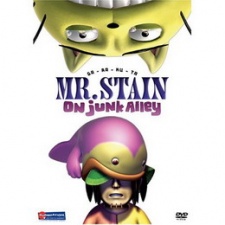GARAKUTA-DOORI NO STAIN
STATUS
COMPLETE
EPISODES
13
RELEASE
March 25, 2003
LENGTH
7 min
DESCRIPTION
Mr. Stain, an artist/inventor, and his cat friend, Palvan, have numerous adventures concerning art supplies and junk found in Junk Alley.
(Source: Anime News Network)
CAST
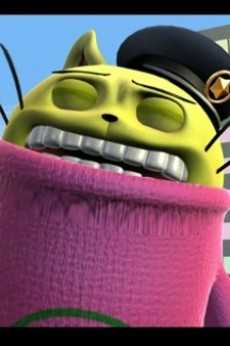
Palvan
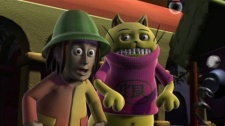
Stain

Takayasu Usui
EPISODES
Dubbed
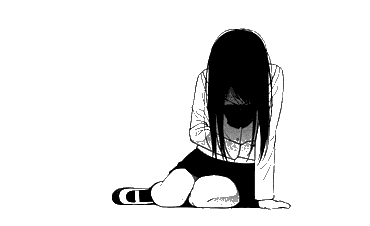
Not available on crunchyroll
RELATED TO GARAKUTA-DOORI NO STAIN
REVIEWS

davidman001
70/100Popee the Performer’s overlooked successor; How Mr. Stain Uses Surrealism to build a sense of Humanity.Continue on AniList
Away from bustling streets of everyday people hastily making their way, past pitch black alleyways, and into dirty corridors occupied by a vast array of strange anthropomorphic animals, you’ll find yourself at a junkyard where the illustrious Mr. Stain resides. Sorry, did I say illustrious? I meant the complete opposite. Mr Stain is an unknown homeless man that spends his days scavenging the dirty junkyard for items he finds interesting. He’s joined alongside the many inhabitants of the back alley, but never in alliance with one another. For if something is found, everyone acts in their own selfish desires—often vile in executions for their own greedy self-gain. This place is dirty, disgusting, and brazenly violent. Yet it’s behind this veil of disgust that Mr. Stain presents to us a surprising depth of humanity and relatability, the kind that pushes you out of your comfort zone and defies sensibilities. Well, at least that’s what I get out of Masuda Ryuuji’s work.
 ##### (A shot of the Junkyard from Episode 1. I love the attention to detail in all of the little objects scattered around the place. This is the most reoccurring location since it's where Mr. Stain often finds his items that each episode is based around.)
##### (A shot of the Junkyard from Episode 1. I love the attention to detail in all of the little objects scattered around the place. This is the most reoccurring location since it's where Mr. Stain often finds his items that each episode is based around.)Because yes that’s right, this is another work by Masuda Ryuuji, the creator of Popee the Performer, and one that is often overlooked compared to its predecessor. Airing just two years after Popee the Performer and a run of just 13 short episodes and a 30 minute OVA finale, Mr Stain builds itself a unique identity that somehow takes even more creative liberties than Popee the Performer. Rather than working within the restrictive limitations of its budget and software, Masuda builds upon the creative foundations he built during the production of Popee and expands on them to achieve even more of his bizarre ideas in Mr Stain. However before we get into that, I need to preface this review with a recommendation to read my Popee the Performer review if you haven’t, as it adds much needed context for this review.
Upon starting the first episode of Mr. Stain, the first thing you’ll notice is the detailed background designs, atmospheric lighting and effects, and a multitude of objects occupying the space. This is in direct contrast to the limitations faced during the production of Popee the Performer which took place in a simple, flat desert plain. Masuda Ryuji wanted to make the world of Mr. Stain feels more alive and interesting, thus a meticulous focus is placed on set design and atmosphere.



 ##### (Various screenshots of the surrounding city and inside the corridors/rooms.)
##### (Various screenshots of the surrounding city and inside the corridors/rooms.)Alongside this focus on backgrounds is a significant improvement to the camerawork. Part of Masuda’s decision to place Mr. Stain amongst tall buildings is a desire to express a sense of physical space in animation, much like a camera does in live-action films. By utilising 3DCG, he’s able to easily convey this idea due to the camera being a literal physical object within that space. It goes without saying that traditional hand-drawn animation can achieve a similar effect, but it requires an immense amount of time and skill. By utilising computer technology, Masuda is able to bring his desired cinematic style into animation. As Masuda Ryuji puts it: “The main attraction of 3D CGI animation for me is the potential to combine the best elements of live-action camera work and animated expression. In simple terms, with 3D CGI, you can virtually build a set inside a computer, similar to stage design in live-action, and place a camera within it to move around. This allows for realistic camera movements—such as circling around a character or raising the camera like on a crane—enabling direction beyond simple cuts.” (Masuda, Oct2009). You can see the result of this in the first episode, for example, when Mr. Stain and his cat buddy (if you can even call them friends) Palvan enter a room. Instead of cutting away to a different shot, Masuda utilises the free flowing camera to crane upwards, showing the characters walking through windows, and up to the roof of the building, all in one seamless take (refer to Figure 1) Mr. Stain constantly has shots where the camera circles around characters, such as in episode 2, which does a great job at establishing the surrounding area and showing unique angles and details you’d otherwise not see (refer to Figure 2). All of this does wonders to bring the space occupied by Mr. Stain to life.
##### (Figure 1; Episode 1: Mr. Stain and Palvan entering a building with a continuous camera shot that cranes upwards.) ##### (Figure 2; Episode 2: Mr. Stain Scavenging through the junkyard with a spiralling camera shot that establishes the surrounding space.) This purposeful and meticulous focus on establishing a sense of space achieves realism, too. Unlike Popee the Performer, which indulges in its absurdity to form surrealist humour, Masuda attempts something completely different with Mr. Stain to achieve a similar level of surreality. The titular character, Mr. Stain, is deliberately designed with more human-like features; his movements are smooth and lively (in contrast to the rigid movements found in Popee the Performer); and he exhibits emotions and reactions the viewers can relate to. Mr. Stain is often portrayed acting illogically, such as in episode 3 where Mr. Stain falls in love with a portrait of a woman in a painting, to the extent that he’ll stop eating (and taking care of himself in general) to stare upon her figure for hours. Palvan attempts to please Mr. Stain by adding to the painting the image of Mr. Stain, but he becomes furious upon seeing himself, perhaps disgusted by his own image next to someone who, in his eyes, is perfect and beautiful. Enraged, he furiously rips apart the part of the painting that Palvan drew on, with a bloody hand from the broken glass shard he uses. This scene is raw in its disgust and incredibly uncomfortable to watch, and that’s the point. In Masuda’s own words: “People are emotional creatures. They tend to react emotionally more than logically. So rather than create designs written on paper, I have characters react emotionally - and interestingly - to the story.” (Masuda, 2006) With this idea in mind, Masuda is able to create characters that feel real. Characters you’ll find yourself genuinely compassionate towards. Characters who have a heart, in spite of the surrealist moments throughout the series. Masuda is also attempting to portray a “strange realism,” the kind that makes you feel uncomfortable on purpose to portray the rawness and brutality of this setting and these characters.


 ##### (From Episode 3. I'm pretty sure Masuda specifically references this episode in his interview so if you're interested to hear what he says I highly recommend watching that (I have it linked below)
##### (From Episode 3. I'm pretty sure Masuda specifically references this episode in his interview so if you're interested to hear what he says I highly recommend watching that (I have it linked below)To get an idea of what I’m saying, look no further than episode 4 where Mr. Stain finds a bird in a cage in the junkyard and, of course, tries to eat him, but he manages to escape. However, the bird then saves Stain from falling to his death, which leads to the two bonding with each other. But the bird died because of the change in season as it was a summer bird. So Mr. Stain violently chops up the bird, cooks it, and stuffs it in his mouth (see Figure 3). Masuda talks about in an interview about how when he was young he would see chickens being chopped up this exact way, so he was very used to this kind of unapologetic violence.
##### (Figure 3; Episode 4: Mr. Stain doing... some horrific things to that chicken... dear god have mercy on that poor thing...) All of these scenes are disgusting and uncomfortable. Mr. Stain’s art is weird and gross. Yet everything is portrayed in a strangely real and relatable way—exactly what Masuda is trying to achieve. Characters that are morally questionable and disgusting, yet undoubtedly human. It’s able to tug at your heartstrings and make you genuinely care for these characters, even after (or during) these brutal and disgusting scenes. Alongside the art amplifying a sense of realism, everything makes for such a surreal experience. If I haven’t sold the idea that Mr. Stain is incredibly surreal yet, during the last scene of episode 2, the lizard that hung out with Mr. Stain and Palvan dies and his ghost rips a fat cigar right in front of their faces before ascending to heaven (see Figure 4; or literally right below this sentence, lol).
##### (Figure 4; Episode 2: this shit is so funny to me lol) Everything about Mr. Stain is batshit insane, yet the fact that it’s able to build a world and establish characters that feel relatable is impressive. I’ve got one more quote from Masuda to ponder: “I’ve always been drawn to stories where things don’t quite come together perfectly, often with an ironic twist. It’s something closer to Terry Gilliam’s style of humour [Monty Python] than to typical Hollywood movies. I also loved manga growing up and frequently read works like Phoenix by Osamu Tezuka. It’s not a happy-ending story—instead, it explores themes like life’s disjointedness and challenges. And because of that, the ‘fate’ that sweeps the protagonist along takes on a strange weight, a unique realism. It’s not just gritty; it’s more like a vastness that leaves you awestruck once you finish reading.” (Masuda, Oct2009).



 ##### (Various screenshots to provide a taste of what to expect from Mr. Stain's absurdity and surrealism.)
##### (Various screenshots to provide a taste of what to expect from Mr. Stain's absurdity and surrealism.)I find Mr. Stain to be a significant part of Masuda Ryuuji’s portfolio of 3DCG anime for all the reasons I’ve discussed in this review. He was able to more freely explore the wicked, and oftentimes grim, ideas he has. You can feel his creativity overflowing throughout Mr. Stain, be it through the characters or set pieces. It’s a shame that Mr. Stain is often overlooked in comparison to its significantly popular predecessor, since I believe it provides a similar level of crude and wicked absurdity that made Popee the Performer so charming in the first place.
And to end on a similar note as my Popee the Performer review, Mr. Stain is the idea of rejecting your sensibilities and embracing unconventionality personified into a story. Mr. Stain is the kind of anime you can very easily dismiss on a surface level for its strange art style and disgusting story. Yet it’s exactly these aspects that challenge the viewer’s sensibilities, as it’s able to portray a surprising sense of humanity throughout its surrealism. It’s visceral, raw, and real, all of which makes for such a truly unique experience that I highly encourage anyone interested to try. Thanks for reading this review <3.

 ##### (From the deeply traumatic 13th episode.)
##### (From the deeply traumatic 13th episode.)-Sources-
- Masuda Ryuuji Interview for Mr. Stain https://www.youtube.com/watch?v=1LTagdc7pVg&list=PLtABcpnRh2OyYD6f6zHHyl7JOTRvvc7s4
- Adobe Education Interview https://web.archive.org/web/20141129032634/https://www.adobe-education.com/jp/interview/interview18.html
SIMILAR ANIMES YOU MAY LIKE
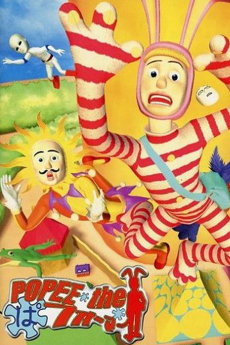 TV SHORT ComedyPopee the Performer
TV SHORT ComedyPopee the Performer
SCORE
- (2.65/5)
MORE INFO
Ended inMarch 25, 2003
Favorited by 11 Users


